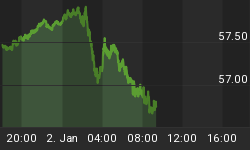
In December 1997 you could have purchased Intel for 18 times unexpensed historical earnings. Today you can purchase Intel for 18 times unexpensed historical earnings. I think Intel was overvalued in December 1997 and equally, if not more overvalued today. Why? Because one of the most important valuation matrixes going - Return on Equity - suggests that the company is no longer a super growth story.

The argument could certainly be made that I have flipped my rocker; that Intel is a better buy today than it was in December 1997. The story goes that since Intel shares are down more than 40% since January and the company continues to report strong financial results, a buying opportunity has developed. When looking at one chart in particular - free cash generation versus stock price - it would appear that Intel shareholders are front running a fundamental financial collapse that may, or may not arrive.

But alas, history has taught us that tech is cyclical. To counter the FCF chart one chart will suffice: inventories. Rising inventories are the reason why investor's have been apprehensive about Intel's margins for months, and rising inventories are the reason why investors should have been apprehensive about tech overcapacity issues in 2000.

But do rising inventory levels at Intel and numerous other tech companies mean that a 2000 style crash looms? I don't think so. Rather, instead of trading at 11 times book and 12 times sales (as was the case in mid-2000) Intel currently trades at 3.2 times book and 3.8 times sales (after today's sell off). My quarterly statistics go back as far as 1997 and these are the lowest p/b and p/s totals on Intel's record. As for manipulated earnings, don't look at them! Instead focus on free cash flows*. Intel currently trades at a respectable 14.6 times free cash and - despite the downturn in 2000-2003 - the company has only reported negative flows 4-times over the last 7.5 years (30 quarters). Rising inventory levels don't mean no cash generation at Intel, just smaller cash generation.
In short, while the degree of damage in tech from 2000-2002 is unlikely to be mirrored going forward - stocks like Intel do not have as much room to fall - there nonetheless remains a strong likelihood that rising inventory levels at companies like Intel have again marked an end to the good times. As for all of the Intel valuation matrixes that are near 7+-year lows, it is worth remembering that other statistics - including top line margin and ROE trends - are the reason why premiums have declined. Intel, once a growth story, is morphing into a mature cyclical stock, and cyclical stocks typically do not continue trading near 20 times manipulated earnings when times are rough.
* Intel's semi attractive price/FCF ratio are/may be influenced by 1) Tiny dividend payouts (less than 5% of CFO in 2003), and 2) What could prove to be an unsustainable recovery in business over the last four quarters.
















